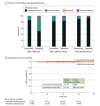Efficacy of Nivolumab and AVD in Early-Stage Unfavorable Classic Hodgkin Lymphoma: The Randomized Phase 2 German Hodgkin Study Group NIVAHL Trial
- PMID: 32352505
- PMCID: PMC7193521
- DOI: 10.1001/jamaoncol.2020.0750
Efficacy of Nivolumab and AVD in Early-Stage Unfavorable Classic Hodgkin Lymphoma: The Randomized Phase 2 German Hodgkin Study Group NIVAHL Trial
Abstract
Importance: In early-stage unfavorable classic Hodgkin lymphoma (cHL), conventional therapy induces high cure rates but also relevant acute and long-term toxic effects. Nivolumab is well tolerated and highly effective in relapsed/refractory cHL but has not been adequately studied in first-line treatment of early-stage cHL. The NIVAHL trial evaluated nivolumab in this setting with the aim to develop a highly effective yet tolerable systemic therapy to ultimately mitigate morbidity in patients who survive cHL.
Objective: To evaluate efficacy of 2 experimental nivolumab-based first-line treatment strategies in patients with early-stage unfavorable cHL.
Design, setting, and participants: This was an open-label, multicenter, phase 2 randomized clinical trial, open between April 2017 and October 2018. The trial took place at 35 trial centers across Germany, ranging from academic centers to private offices. Eligibility was defined by age 18 to 60 years, cHL confirmed by expert pathology review, early-stage unfavorable disease by German Hodgkin Study Group criteria (stage I to II with risk factor[s]), and absence of serious concomitant disease or organ dysfunction. Among 110 enrolled patients, 109 were eligible.
Interventions: Systemic therapy, per random assignment (1:1) to either concomitant treatment with 4 cycles of nivolumab and doxorubicin, vinblastine, and dacarbazine (N-AVD) or sequential treatment with 4 doses of nivolumab, 2 cycles of N-AVD, and 2 cycles of AVD at standard doses, followed by 30-Gy involved-site radiotherapy.
Main outcomes and measures: Complete remission (CR) rate after study treatment, aiming at excluding a CR rate of 80% or lower via a 2-sided 95% CI for each treatment group.
Results: Of 109 patients included in this study, 65 (59.6%) were women, and the median (range) age was 27 (18-60) years. At interim staging after 2 cycles of N-AVD or 4 doses of nivolumab monotherapy, 54 of 54 (100%) and 49 of 51 (96%) response-eligible patients, respectively, achieved an objective response, with CR in 47 (87%) and 26 (51%) patients, respectively. Among 101 patients eligible for primary end point analysis, 46 of 51 (90%; 95% CI, 79%-97%) patients receiving concomitant therapy and 47 of 50 (94%; 95% CI, 84%-99%) patients receiving sequential therapy achieved CR after study treatment. With a median follow-up of 13 months, 12-month progression-free survival was 100% for patients receiving concomitant treatment and 98% (95% CI, 95%-100%) for patients receiving sequential therapy.
Conclusions and relevance: Both strategies combining nivolumab and AVD are feasible and resulted in high remission rates. Despite narrowly missing the efficacy benchmark in the concomitant group, the excellent 12-month progression-free survival and the unexpectedly high CR rate after 4 doses of nivolumab monotherapy warrant further evaluation of this approach in the first-line treatment of patients with early-stage cHL.
Trial registration: ClinicalTrials.gov Identifier: NCT03004833.
Conflict of interest statement
Figures


References
Publication types
MeSH terms
Substances
Associated data
LinkOut - more resources
Full Text Sources
Medical
Miscellaneous

